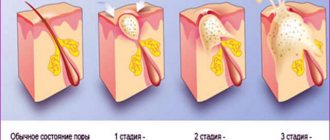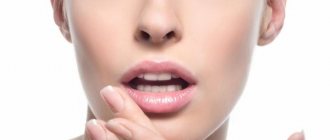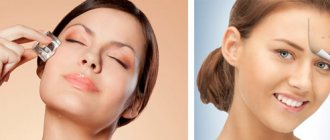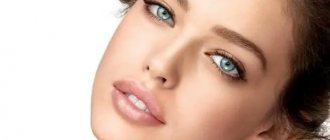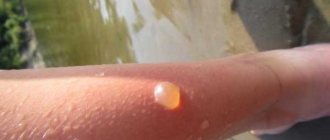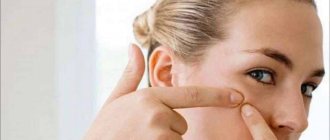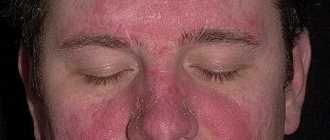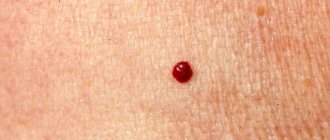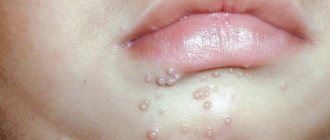Herpes on the face is nothing more than a manifestation of viral activity of the HSV-1 type. Most often, the disease affects the lips, but can also spread to the ears, nose or eyes. In the absence of adequate therapy, activation of the virus in the eyes can lead to significant deterioration of vision.
Today we will talk about what herpes on the face is and how to treat it.
What is herpes on the face?
Herpetic lesions of the skin and mucous membranes of the face are one of the most common manifestations of the herpes virus.
When the immune system is weakened, the disease can manifest itself on the entire face, including:
- cheeks;
- eyebrows;
- lips;
- forehead;
- bridge of the nose
A feature of this disease is severe discomfort and aesthetic problems. In some cases, the patient experiences severe pain and clinical symptoms of general intoxication.
The manifestations and characteristics of any herpetic infection depend on:
- type and type of pathogen;
- type of infection;
- state of human immunity;
- previous concomitant infections and diseases.
The manifestation of herpes on the face is characteristic of viruses of the first (simply herpes) and third (the causative agent of herpes zoster) types . Other types of the disease do not occur on the face.
A feature of herpes simplex type 1 is the ability to penetrate epithelial, nerve and lymphatic cells without provoking the human body to a pronounced immune response.
Thus, partial masking of infection is ensured and the ability to tightly connect with the genetic material of human tissues is ensured. What is important is that the virus may not manifest itself in any way until the person’s immune system is weakened.
A feature of type 3 herpes infection is its primary manifestation in the form of chickenpox . In the vast majority of cases, primary infection occurs in childhood, and is accompanied by a violent reaction of the immune system in the form of fever and numerous rashes.
However, this does not prevent the virus from penetrating large nerve trunks and ganglia, where the infection remains latent for the rest of life . As soon as provoking factors begin to affect the body, the virus is activated and manifests itself in the form of a clinical picture of herpes zoster in the facial area.
Related article:
How is vaginal herpes treated? What are the dangers of illness during pregnancy?
Herpes on the cheek in a child treatment
Colds on the face: treatment recommendations
Recommendations for the treatment and prevention of colds on the face
Causes of redness on the cheek in an adult and how to get rid of it
It is advised that initially, when a cold appears on the face, visit a dermatologist for advice on antiviral drugs and their correct use. And with the prescription already written out, you can go to the pharmacy.
If you have a cold on your face, you can use ointments such as Acyclovir or Zovirax. They must be applied to cold rashes 3 times a day until completely cured.
Treating a cold on the face with toothpaste - regular toothpaste has a drying effect. It must be applied to the lips if there is a feeling of itching, which is the precursor to the appearance of blisters. But you need to use mint toothpaste. You can’t even expect any effect from fruit.
A therapist or dermatologist may prescribe immunomodulators as treatment. At home, you can replace them with more vitamin C or lemon.
To treat herpes, you can also use raspberry branches. It is necessary to wash them in water and chop them. The resulting porridge is applied to a cold for 10-15 minutes daily and several times a day.
Treatment with Valocordin - thoroughly soak a tampon in the medicine, and then apply it to the areas affected by herpes. This remedy is more effective in the first stage of herpes.
Also, as a highly effective remedy, it is recommended to apply a cut leaf of Kalanchoe or aloe to herpes. Alternatively, you can simply lubricate your lips with the juice of these plants.
For a cold on the face, you can use a compress made from garlic juice mixed with honey and wrapped in gauze.
What is the danger of the virus?
The danger of the disease is observed during its exacerbation
. which is explained by the possibility of infecting other people with the virus.
How does herpes simplex occur?
Herpes in an infant is characterized by enlarged lymph nodes. Symptoms of the disease manifest themselves in the form of increased body temperature and upset stool. The presence of rashes in children is observed on any part of the body.
What is the peculiarity of relapse of the disease?
When the immune system is weakened, herpes immediately appears on the child’s cheek or any other part of the body. If the baby’s immunity works well, then manifestations of the disease are not observed.
After the body gains strength, the skin rash will disappear, the temperature will decrease and other symptoms will disappear. But there will be an infection in the blood that does not manifest itself, so prevention must be constantly carried out.
How to treat herpes during exacerbation?
It is mandatory to treat herpes in a child during an exacerbation period.
. If the baby experiences itching in the areas of the rash, treatment is carried out using lotions.
To destroy bubbles, medications are prescribed that are characterized by a drying effect:
Children's herpes in the mouth area should be treated with rinses. For this purpose, Rivanol, Furacilin, infusions of rotokan or calendula are used. In addition to medications, physical therapy can be used for treatment.
Herpes on a child’s bottom, as well as on other areas, cannot be treated with hormonal ointments.
What are the features of herpes zoster?
Shingles type of disease
occurs due to exposure to the virus that causes chickenpox. That is why the symptoms of these two diseases are very similar.
How to prevent herpes?
If a young patient experiences frequent relapses, then he is prescribed general restoratives in the form of:
Medicines are characterized by lack of toxicity and anti-allergenicity. That is why their use is safe for the health and life of the baby.
Medicines should be used to treat pathology only as prescribed by a doctor.
Causes of herpes on the face
A person can become infected with herpes at any time , after which he becomes a carrier of the virus.
The appearance of a compacted blistering rash covered with yellow crusts indicates that the disease has become more active under the influence of certain factors. Factors that provoke activation of herpes simplex virus 1 strain include :
- avitaminosis;
- frequent colds;
- bad habits;
- metabolic disorders;
- long-term antibiotic therapy;
- severe illnesses that weaken the body;
- excessive overheating/hypothermia of the body;
- stressful state;
- exhaustion of the body;
- excessively low-calorie diet.
Despite the fact that the cause of herpes on the face can be anything, a prerequisite for the activation of the virus is always a weakened immune system . That is why herpes on the face of both children and adults is often accompanied by an acute respiratory disease.
Diagnostics
Before starting comprehensive treatment for facial rashes, it is important to make a correct diagnosis. When rashes first appear, you should consult a doctor; a specialist will help you determine a diagnosis and treatment plan.
The doctor will take into account the following examination data:
- Examination of the rash - characteristic signs of herpes help make a preliminary diagnosis.
- A general blood test will indicate signs of viral inflammation in the body.
- Biochemical blood test is rarely performed and does not have specific indicators for herpes infection.
- Enzyme immunoassay - will show the presence of antibodies in the blood serum. They can remain for life even after an infection, so the method is not specific.
- Polymerase chain reaction - allows you to determine the DNA of the virus quantitatively. This helps to make a diagnosis with high accuracy.
Laboratory methods for viral infections caused by viruses play a supporting role. Having discovered rashes on the face and head, correlating them with medical history, the doctor is already able to make the correct diagnosis.
What does herpes look like on the face?
The manifestation of herpes on the face depends on the type of virus and the stage of the disease.
At the very beginning, itching or burning occurs . In addition, the person begins to notice a general malaise, accompanied by weakness and fever.
Subsequently, the affected area begins to swell and become covered with small itchy blisters with serous contents. The diameter of individual elements can reach five millimeters.
Then the volume of liquid inside the bubbles gradually increases, and the contents rot. After two or three days, the swelling subsides and the blisters open. The affected area is covered with loose serous crusts.
Over the next week, the inflammation usually subsides completely.
It is important to understand that if the disease is not stopped in time at the initial stage, then the process will not be stopped later . In case of relapse, herpes will appear in the same place.
To avoid infection of healthy areas, you should thoroughly wash your hands with soap and water after each touch of a herpetic rash.
Scratching the affected areas, even with unbearable itching, is strictly prohibited - the infection will quickly spread to healthy areas of the skin.
Symptoms and causes of herpes
Herpes on the cheek manifests itself in the form of ulcers, blisters and rashes. It often occurs during colds, when the body's protective functions are reduced.
There are various causes of herpes:
- seasonal lack of vitamins and microelements in the body;
- poor nutrition;
- a sharp decrease in body weight;
- hypothermia;
- unstable psycho-emotional state;
- stress, depression, neurosis;
- immune diseases;
- long-term use of antibiotics;
- bad habits;
- metabolic disorders;
- transferring complex diseases;
- exacerbation of chronic diseases;
- chronic fatigue;
- colds;
- direct contact with a carrier of the virus;
- failure to comply with personal hygiene rules.
Herpes becomes more active in the autumn-spring period, when the necessary conditions are created for the spread and activity of pathogenic viruses and bacteria.
The symptoms of herpes vary depending on the stage and cause of the disease. Herpes on the cheek develops in 4 stages:
- Tingling, itching, redness of the area of skin where the virus appears.
- Inflammatory process. A bubble filled with liquid appears on the surface of the cheek.
- Ulceration. The bubble bursts and a wound appears in its place.
- Formation of crust and healing of ulcers.
The main manifestations of the disease are:
- itching;
- redness, burning, numbness of the skin;
- pain syndrome;
- increased body temperature;
- headache;
- enlarged lymph nodes;
- chills;
- increased sensitivity;
- general malaise.
Herpes blisters contain blood and viral microorganisms, which, when they get on the skin and open wounds, cause re-infection. After treatment, small scars, scars and damage may remain on the surface of the skin.
Features of personal hygiene in case of herpetic lesions of the face
Doctors strongly recommend that when herpes appears on the face, the infected area should be kept absolutely clean, since when the blisters are opened independently, the risk of infectious bacterial damage to the sores increases several times.
It is important to understand that infection can provoke a new, more serious and dangerous inflammatory process. Related article:
Herpes in the nose - causes and symptoms, what it looks like. How to get rid of it at home
Hygiene procedures during treatment of herpes should be performed according to the following rules:
- It is necessary to avoid long hot baths. It is recommended to wash in a warm shower ;
- using scrubs and washcloths to treat the affected area is strictly prohibited;
- To get rid of moisture, the inflamed areas must be carefully blotted with a towel; you cannot wipe them thoroughly ;
- It is necessary to use two towels - separately for infected and healthy skin. The towel for contaminated areas should be washed after each use.
Special therapeutic baths can be taken only as the acute stage of the disease subsides. Germicidal baths with pine oils, sea salt and oil extracts of tea tree or sage oil (5-6 drops per bath) will be useful.
Taking medicinal baths for herpetic skin lesions will not harm only if the temperature of the water and body coincides.
Herpes on the face - video
How to treat symptoms and complications
The only treatment to suppress the virus and relieve symptoms is antiviral drugs. However, they are effective only in the first 2-3 days after the onset of the disease, that is, from the moment the general symptoms appear. The danger is that people usually associate common symptoms not with herpes, but with a cold, thereby missing the time when treatment will be effective. There are no other remedies against the virus, so in such conditions it is only possible to maintain immunity as a therapeutic measure.
Antiseptic solutions (chlorhexidine, methylene blue, fucorcin, brilliant green), antiviral ointments (Acyclovir, Valacyclovir, Tebrofen ointment, copper sulfate, Zovirax) can be applied locally to the affected area of the forehead. Antibiotics are used only when the disease is complicated and the general condition worsens (fever, chills, etc.).
Of the folk recipes, only those that enhance immunity are effective:
- echinacea;
- liquorice root;
- Kalanchoe;
- chamomile.
They are taken in the form of infusions, ointments, and decoctions.
How and with what to treat herpes on the face?
Before starting treatment, it is necessary to recognize and correctly diagnose the disease in time.
To do this, you should seek help from a highly qualified specialist. As a rule, treatment of herpetic rash involves the complex use of drugs from various groups, including :
- antiherpetic drugs;
- immunomodulatory drugs;
- vitamin complexes;
- special vaccine against herpes.
As practice shows, for the treatment of mild forms of the disease the most suitable drug is Acyclovir , the use of which is acceptable for ordinary patients, pregnant women, and children.
Famciclovir is prescribed to eliminate pathological cells while preserving normal ones. The drug is especially effective against shingles and more complex types of the virus.
"Cycloferon" is used for immune correction, relieving inflammation and suppressing pathogens.
At the same time, to quickly heal wounds and neutralize bacteria accumulated on the affected area of the skin, it is recommended to use the following creams and ointments :
- "Virosept";
- "Bepanten";
- "Depanthenol";
- "Hexpanthenol Hemofarm";
- "Panthenol";
- "Pantoderm".
Only timely diagnosis and a properly selected set of drugs can quickly cure a person of herpes on the face.
Treatment of herpes on the face - video
Drug treatment
Treatment of herpes on the face involves, first of all, visiting a doctor. The doctor will conduct an examination, interview the patient and, based on the data received, prescribe the appropriate prescription. Only a specialist should prescribe how to treat herpes on the face. Independent choice of remedy can cause complications.
The following medications help get rid of colds on the face:
- local ointments;
- vitamin complexes;
- immunomodulatory agents.
How to quickly cure herpes? When herpes appears on the face, the following ointments will help eliminate its external signs and relieve irritation and pain:
- Erythromycin. An inexpensive product that currently has no analogues. Effective due to its antibacterial properties.
- Oxolinic. This ointment relieves itching well. It's cheap and safe. Does not cause individual intolerance. The standard course of treatment is 2 weeks.
- Hyporamine. Natural based ointment with the addition of sea buckthorn. Gently eliminates herpetic lesions of the facial skin. Effectively and timely fights the effects of the virus, regardless of its location.
- Zovirax. Acyclovir-based drug. Able to overcome external manifestations and quickly cure herpes on the face. It disrupts DNA duplication of the virus, i.e. it limits reproduction. Then causes his death. However, with prolonged use it causes resistance in some strains of viruses.
- Acyclovir. The most effective remedy to combat herpes. It works similarly to Zovirax. These two ointments are based on the same active ingredients.
- Viferon. The ointment is based on the action of interferons - activators of the natural human immune system. Under the influence of the drug, cells become more resistant to the virus. This product has virtually no contraindications for use.
- Levomekol. Responsible for accelerated regeneration of damaged skin.
How many days does it take before the ointments start to work? The minimum course is a week, but often lasts longer.
How to cure ocular herpes? There are ophthalmic ointments for this:
- Acyclovir 3%.
- Vidarabine 3%.
- Zovirax.
- Tebrofen.
- Florenal.
When a cold appears, how to treat it from the inside? The following will help weaken the effect of the virus and drive it back into hibernation:
- Acyclovir.
- Zovirax.
- Valtrex.
- Famvir.
Tablets for oral use are not always prescribed: in most cases, ointments work well alone.
To get rid of herpes on the face, it is also necessary to include immunomodulators in the treatment:
- Isoprinosine.
- Galavit (at the first symptoms).
- Anaferon.
They will restore the vitality of the body and strengthen the immune response to viruses. Before treating a cold on the face with one of the selected medications, you should consult your doctor.
Please note: only comprehensive treatment can quickly eliminate herpes on the cheeks, forehead, and lips. Do not forget about regularly taking medications and using medicinal ointments: only then can we talk about a quick and effective fight against herpes.
Traditional methods of treating herpes on the face
The most effective folk methods for treating herpes on the face at home are the following methods :
- mix a paste of two cloves of garlic, 8 grams of flour, 30 milliliters of yogurt, 7 grams of instant coffee and 7 grams of honey. Apply the resulting ointment to blistering lesions once a day;
- Infuse 20 grams of propolis in 50 milliliters of alcohol for a week. Wipe the affected surfaces with the resulting product and take 20 drops of tincture orally;
- treating the skin with essential oils of cedar, fir, geranium, bergamot, eucalyptus and tea tree helps relieve inflammation and significantly accelerate the regeneration of ulcers;
- mix 1 teaspoon of calendula, 2 teaspoons of meadowsweet and 0.5 liters of alcohol. Infuse the resulting mixture for 27 days in a dark room, then filter. Soak a cotton swab with the tincture and apply to the affected area three times a day for 15 minutes. The method is good for frequent relapses of the disease;
- decoctions of raspberry leaves, currants, viburnum or rose hips are an excellent immunostimulant;
- Ordinary cloves help to avoid relapses of herpes. To do this, you need to slightly dissolve five heads of the plant, chew them thoroughly and swallow them.
Related article:
All about the disease herpes. Causes, symptoms and treatment
Thus, the key to stable remission of the disease is maintaining immunity. Otherwise, the disease will remind itself every time the body is weakened under the influence of external or internal factors.
